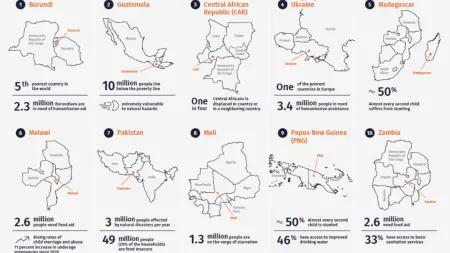CARE highlights humanitarian crises with the least global media coverage / Burundi’s conflict and food insecurity crisis ranks n° 1
GENEVA (January 12, 2021) — Today the international aid organization CARE launched its annual report highlighting the ten most under-reported humanitarian crises of 2020. The analysis is based on online media coverage in five languages throughout the year. CARE sees a concerning trend of crises being neglected year after year.
Six out of the ten crises are located on the African continent. The Central African Republic has appeared in the ranking for five consecutive years. Both Madagascar and Burundi – the latter this year’s number 1 with the least media coverage – have made CARE’s list four times so far. This lack of attention adds to burdens such as the severe effects of COVID-19 restrictions and the growing impact of climate change in these countries.
“Covid-19 has shown us that humanitarian crises can occur anywhere”, says Delphine Pinault, CARE International’s Humanitarian Advocacy Coordinator and UN representative, “but for so many people, especially women and girls, Covid-19 is just another threat on top of what they must face already. We must not be silent while the world ignores crises that started long before Covid-19 and yet still have not been addressed.”
In mainstream news reporting, it is the global pandemic that has dominated national and global headlines since the outbreak. Once its potential for widespread infection and health system chaos was understood, countries and their media understandably turned their focus inwards; on protecting citizens and preventing the virus from spreading. But the effects of COVID-19, coupled with the growing impacts of climate change, have increased the number of people requiring humanitarian assistance by 40 percent – the single largest increase ever recorded in one year: The UN estimates that more than 235 million people will need humanitarian assistance in 2021.
CARE’s report gives an overview of neglected crises and their impacts, but also offers solutions and best practices in journalism. Seven media practitioners from around the globe offer insights into their reporting routine and show that neglected crises can be covered, with perseverance and deliberate editorial choices.
The 10 most under-reported crises of 2020 are:
- 1. Burundi
- 2. Guatemala
- 3. Central African Republic
- 4. Ukraine
- 5. Madagascar
- 6. Malawi
- 7. Pakistan
- 8. Mali
- 9. Papua New Guinea
- 10. Zambia
Recommendations: What can be done to raise attention for silent crises?
Photo: 48-year-old Stephen participated in CARE’s Southern African Nutrition Initiative, in which he and his wife learned about the importance of nutritious foods, hygiene and sanitation, as well as the importance of sharing responsibilities with his wife.
Donors: In the spirit of multilateralism, we urge donors to maintain, and where possible, increase their commitment to ensure that humanitarian needs are met everywhere, including in ‘forgotten crisis’ and we urge donors to fund media organizations and journalists, including women led and women / gender focused media organizations and outlets that tell the story of how disproportionately women and girls are affected by crisis and how their organizations are on the frontline of the response.
Governments: Free flow of information is necessary for democratic systems and even more critical in times of crisis. Allow access for journalists, protect the lives of journalists and make it less dangerous for them to report the news. Between 2006 and 2019, close to 1,200 journalists were killed.
Aid organizations: Invest in media in ‘forgotten crisis’ and in their capacity to report accurate, reliable and gender sensitive information. Organizations should increase their support to assist journalists by providing quality research, insight, context and capacity building support, to shine a light on lesser known, yet important stories, including on the impact and resilience of women and girls, and linking them to trustworthy and accurate sources, translators, photographers and experts.
Media: International media should use the pandemic as an opportunity to change the current narrative and amplify local voices, with special attention to women and girls. Seek partnerships with local media organizations. They do not only better understand the context, they also tend to have better connections on the ground.
To read the full report
Note to editors: Using the media monitoring services of Meltwater Group, CARE analyzed those natural disasters or conflicts that received the least media attention in 2020. More than 1.2 million global online sources were monitored in English, French, German, Arabic and Spanish. To filter according to scale, we chose countries in which at least one million people were affected by natural or man-made disasters, according to data by Reliefweb, ACAPS and CARE’s own data. The result was a list of 45 crises that were then screened in Meltwater’s database for the time period of January 1 to September 30, 2020. The report ranks the top ten crises receiving the fewest media attention, meaning the least amount of online media coverage. This is the fifth edition of CARE’s neglected crises report. In 2020, the most under-reported crisis is Burundi, followed by Guatemala and the Central African Republic. A year ago, in 2019, Madagascar was at the top of the ranking. This annual analysis serves as a reminder and appeal to make room for ‘forgotten crises’ in both media and political debates.
About CARE: Founded in 1945 with the iconic CARE package, CARE is a leading humanitarian organization working around the globe to save lives, defeat poverty and achieve social justice. CARE places a special focus on working alongside girls and women because, equipped with the proper resources, they have the power to lift families and entire communities out of poverty. CARE works in over 100 countries and reached more than 92.3 million people in 2020.
To learn more, visit www.care-international.org
